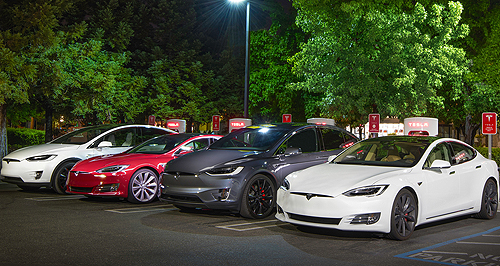Make / Model Search
News - General News - Electric VehiclesEV policies need to shape up: reportCharged up: Greater EV charging infrastructure is one of the needs cited by the Electric Vehicle Council to increase EV take-up in Australia. Government policies slowing take-up of EVs, not consumer interest, says report15 Jun 2017 A SURVEY commissioned by the Electric Vehicle Council has laid the blame at the feet of the government for the relatively low take-up of electric vehicles in Australia, saying that better policies would result in greater EV purchases. Prepared by ClimateWorks Australia, the survey claimed that 50.2 per cent of 504 Victorian consumers would consider buying an electric vehicle if they were in the market for a new car, however 40.3 per cent would not, with range and access to charging infrastructure the main concerns. Another issue was the price of electric vehicles, with the report revealing that while 34.7 per cent of respondents would be willing to pay more for an electric vehicle, the majority would only do so if there was greater support, incentives and infrastructure in place. A further 33.5 per cent said they would be willing to buy an EV if it was the same price as a petrol or diesel vehicle. Despite consumer interest, EVs made up only 0.1 per cent of vehicles sold in Australia last year, with 1369 sales. That number is down on the 1771 sold in 2015. Model availability was one area that has suffocated EV and plug-in hybrid sales in Australia with only three vehicles – the Nissan Leaf, Mitsubishi Outlander PHEV and Renault Kangoo ZE – available in 2016 for under $60,000. Of those three, the Leaf is no longer sold, the Outlander sold out mid-2016 ahead of the arrival of the updated version earlier this year, and the Renault Kangoo is a low-volume light-commercial vehicle that is only available through fleet deals with Renault Australia. Of the 16 electric or plug-in hybrid vehicles for sale in Australia, more than half are priced at more than $100,000, with $60,000-100,000 the next most common bracket, followed by sub-$60,000, with overall sales replicating model availability. Model availability is expected to increase with seven new EV models or updates expected to land in the next 18 months, three of which are expected to be priced at under $60,000. Businesses make up the highest proportion of EV sales with 64 per cent, followed by private buyers (34 per cent) and government fleets (2.0 per cent). Since 2011, Victoria has had the highest number of EV purchases with 1017, but on a per capita basis, the ACT is leading the way with 18 EVs purchased for every 10,000 new vehicles sold – twice as many as the next best state, South Australia. Much of that is to do with the incentives for buying a new electric vehicle state by state, with the survey estimating that on the purchase of a $60,000 EV, ACT residents receive a $2110 discount, compared to $660 in Queensland, less than $250 for NSW, $100 for Victoria and between $40 and $80 for the Northern Territory. Fifty five per cent of respondents said subsidies to reduce the cost of purchase would encourage them to buy an EV, with 53 per cent saying providing subsidies on installing home charging infrastructure and installing public charging infrastructure would act as encouragements. The most important type of charging station would be a public fast charging station that takes 15 minutes for a full charge, followed by a two-hour public station and five-hour workplace station. As for future uptake of EVs, many studies differ with their projections on how many EVs will make up Australia’s light vehicle fleet in the future. ClimateWorks Australia estimates 45 per cent of vehicles with be EVs by 2030, the department of the environment and energy is more conservative with 15 per cent of new light vehicle purchases by 2030, and Australian research organisation Beyond Zero Emissions is particularly optimistic, gunning for 100 per cent of the passenger fleet to be EV by 2030. Globally, the International Energy Agency estimates that by 2030, 10 per cent of light vehicles will be EV. Bloomberg predicts that number will jump to 25 per cent by 2040. For infrastructure, Victoria boasts the highest number of charging stations with 134, ahead of 130 in NSW. The ACT only has 14 in total, but that represents the highest per capita ration with 3.5 per 100,000 residents. Electric Vehicle Council CEO Beyhad Jafari said the results of the report showed that Australians were willing to adopt new, electric vehicle technologies. “What we have in Australia is not a lack of consumer interest in electric vehicles, but a lack of suitable models to choose from,” he said. “The right level of support and standards provide manufacturers with an incentive to invest in Australia by bringing more choice to the market, providing lower cost alternatives.”“With that support driving initial momentum, electric vehicles are particularly attractive as they are cleaner and cheaper to operate.” He also called on the government to enact policies that help a greater uptake of EVs in Australia. “Australia is one of the few remaining developed countries without light vehicle CO2 standards in place,” he said. “Electric vehicles, powered by renewable energy emit zero carbon emissions, while providing a boost to the economy, providing opportunities for investment in Australian industry. “We already have some innovative businesses being developed in Australia to service the electric vehicle industry. With over $50bn already invested in the global electric vehicle industry, now is the time for Australia to take action.”  Read more |
Click to shareGeneral News articlesResearch General News Motor industry news |












Facebook Twitter Instagram